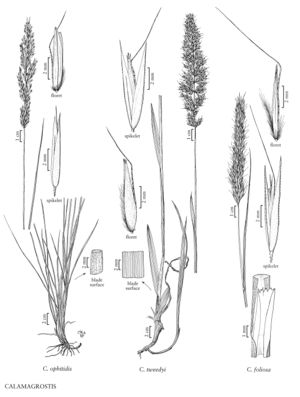Difference between revisions of "Calamagrostis tweedyi"
FNA>Volume Importer |
imported>Volume Importer |
||
| (8 intermediate revisions by 2 users not shown) | |||
| Line 4: | Line 4: | ||
|publications= | |publications= | ||
|common_names=Cascade reedgrass;Tweedy's reedgrass | |common_names=Cascade reedgrass;Tweedy's reedgrass | ||
| + | |special_status={{Treatment/ID/Special_status | ||
| + | |code=E | ||
| + | |label=Endemic | ||
| + | }} | ||
|basionyms= | |basionyms= | ||
|synonyms= | |synonyms= | ||
| Line 17: | Line 21: | ||
-->{{Treatment/Body | -->{{Treatment/Body | ||
|distribution=Mont.;Idaho;Wash. | |distribution=Mont.;Idaho;Wash. | ||
| − | |discussion=<p>Calamagrostis tweedyi grows in montane to subalpine moist meadows and coniferous forests, often in association with Carex geyeri, at 900-2000 m. Its range extends from Washington and Oregon to western Montana.</p> | + | |discussion=<p><i>Calamagrostis tweedyi</i> grows in montane to subalpine moist meadows and coniferous forests, often in association with <i>Carex geyeri</i>, at 900-2000 m. Its range extends from Washington and Oregon to western Montana.</p> |
|tables= | |tables= | ||
|references= | |references= | ||
| Line 26: | Line 30: | ||
-->{{#Taxon: | -->{{#Taxon: | ||
name=Calamagrostis tweedyi | name=Calamagrostis tweedyi | ||
| − | |||
|authority=(Scribn.) Scribn. | |authority=(Scribn.) Scribn. | ||
|rank=species | |rank=species | ||
| Line 33: | Line 36: | ||
|basionyms= | |basionyms= | ||
|family=Poaceae | |family=Poaceae | ||
| + | |illustrator=Cindy Roché;Hana Pazdírková | ||
| + | |illustration copyright=Utah State University | ||
|distribution=Mont.;Idaho;Wash. | |distribution=Mont.;Idaho;Wash. | ||
|reference=None | |reference=None | ||
|publication title= | |publication title= | ||
|publication year= | |publication year= | ||
| − | |special status= | + | |special status=Endemic |
| − | |source xml=https:// | + | |source xml=https://bitbucket.org/aafc-mbb/fna-data-curation/src/200273ad09963decb8fc72550212de541d86569d/coarse_grained_fna_xml/V24/V24_1006.xml |
|subfamily=Poaceae subfam. Pooideae | |subfamily=Poaceae subfam. Pooideae | ||
|tribe=Poaceae tribe Poeae | |tribe=Poaceae tribe Poeae | ||
Latest revision as of 16:21, 11 May 2021
Plants without sterile culms; loosely cespitose, with rhizomes 1-10 cm long, 2-4 mm thick. Culms (47)60-120(150) cm, unbranched, smooth, rarely slightly scabrous; nodes 2-3. Sheaths and collars smooth; ligules (1)3.5-6(8) mm, obtuse, lacerate; blades (3)4-20(38) cm long, (2)3-8(13) mm wide, culm blades wider than 6 mm, flat, abaxial surfaces smooth, adaxial surfaces smooth or slightly scabrous, glabrous or sparsely hairy. Panicles 7-16(19) cm long, (1)1.5-2 cm wide, erect, usually contracted, sometimes interrupted near the base, pale purple to purple; branches (0.2)2.4-6.7(7.7) cm, smooth, sometimes sparsely scabrous distally, spikelet-bearing to the base. Spikelets (4.5)5.5-8(9) mm; rachilla prolongations (0.5)1-2(4) mm, hairs 1.5-3 mm. Glumes keeled, smooth or the keels scabrous, lateral veins prominent, apices acute; callus hairs 0.8-1 mm, 0.2-0.3 times as long as the lemmas, sparse; lemmas (4)4.5-6.5(7.5) mm, 0-1.5 mm shorter than the glumes, scabridulous; awns 6-8 mm, attached to the lower 1/5 – 3/10 of the lemmas, exserted more than 2 mm, stout, easily distinguished from the callus hairs, bent; anthers 2-3.5 mm. 2n = unknown.
Distribution
Mont., Idaho, Wash.
Discussion
Calamagrostis tweedyi grows in montane to subalpine moist meadows and coniferous forests, often in association with Carex geyeri, at 900-2000 m. Its range extends from Washington and Oregon to western Montana.
Selected References
None.
